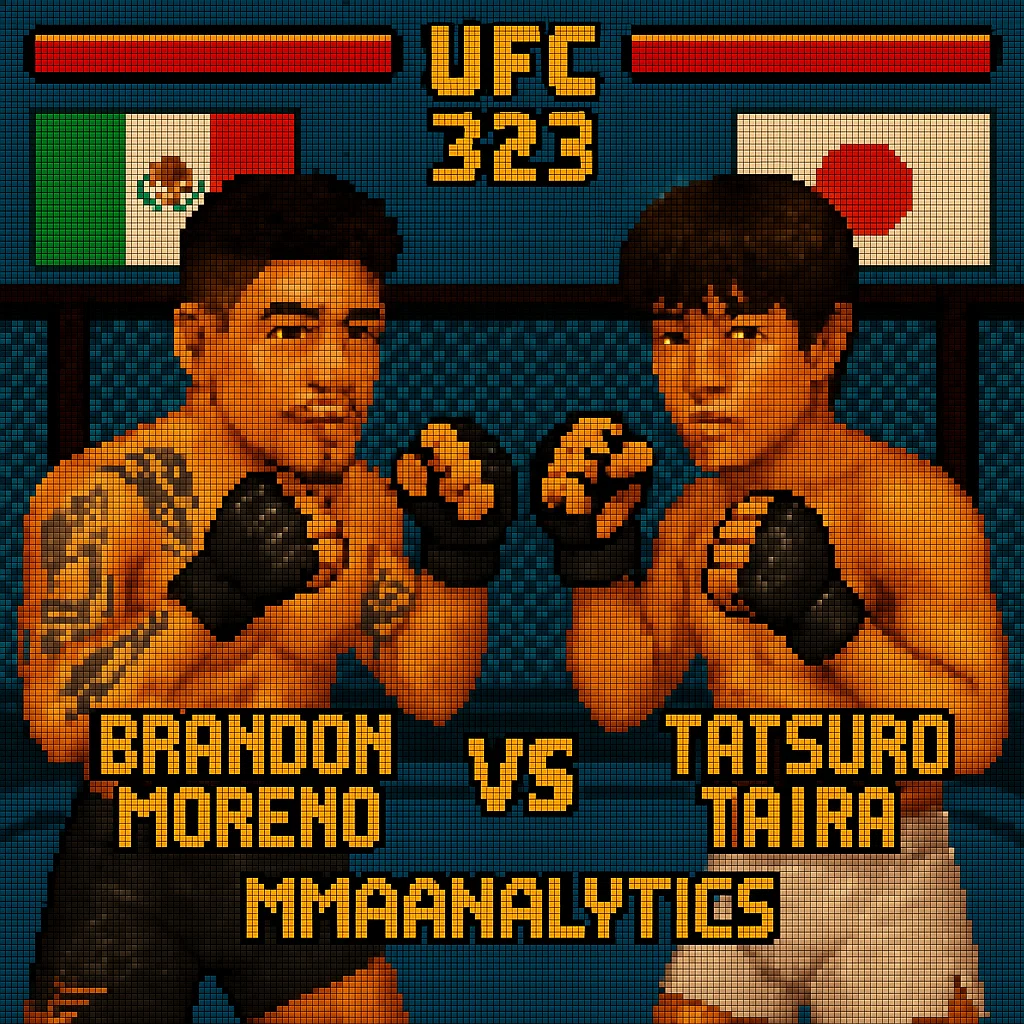Brandon Moreno vs Tatsuro Taira
Men's Flyweight Bout • UFC 323
Saturday, December 6, 2025 • 30ft Octagon (Large Cage)

Explore Detailed Fighter Profiles
Click on either the fighter's name or profile image for each fighter to access comprehensive UFC statistics including striking metrics, grappling data, clinch performance, complete fight history, offensive & defensive analytics, and round-by-round breakdowns.
Brandon Moreno
Fighter Metrics
Victory Methods
Win Round Distribution
Last 5 Fights
| Date | Opponent | Result | Method |
|---|---|---|---|
| 2025-03-29 | Steve Erceg | W | Decision - Unanimous (R5, 5:00) |
| 2024-11-02 | Amir Albazi | W | Decision - Unanimous (R5, 5:00) |
| 2024-02-24 | Brandon Royval | L | Decision - Split (R5, 5:00) |
| 2023-07-08 | Alexandre Pantoja | L | Decision - Split (R5, 5:00) |
| 2023-01-21 | Deiveson Figueiredo | W | TKO - Doctor's Stoppage (R3, 5:00) |
Tatsuro Taira
Fighter Metrics
Victory Methods
Win Round Distribution
Last 5 Fights
| Date | Opponent | Result | Method |
|---|---|---|---|
| 2025-08-02 | Hyun Sung Park | W | Submission - Face Crank (R2, 1:06) |
| 2024-10-12 | Brandon Royval | L | Decision - Split (R5, 5:00) |
| 2024-06-15 | Alex Perez | W | KO/TKO - Leg Injury (R2, 2:59) |
| 2023-12-09 | Carlos Hernandez | W | KO/TKO - Punches (R2, 0:55) |
| 2023-07-08 | Edgar Chairez | W | Decision - Unanimous (R3, 5:00) |
📊 Technical Radar Comparison
Legend & Notes
- • SLpM, TD15, Sub/15 are normalized to 0–100 for plotting.
- • Percent metrics (StrAcc, StrDef, TDAcc, TDDef) are raw %.
- • Tooltip shows true raw values with units.
- • Colors: Blue = Brandon Moreno, Red = Tatsuro Taira.
📊 Detailed Statistical Comparison
🥊 Fight Analysis Breakdown
🏆 Brandon Moreno Key Advantages
Superior striking defense (60% vs 47%) and elite takedown defense (64% vs 45%) create a formidable defensive wall. Moreno's ability to evade strikes while maintaining forward pressure allows him to control range without absorbing excessive damage. His TDD success against elite wrestlers like Amir Albazi demonstrates the reliability of his first-layer sprawls.
With multiple title fights and five-round wars under his belt, Moreno brings a veteran's composure that younger fighters struggle to replicate. His ability to maintain round-winning pace deep into championship rounds is particularly valuable in the large cage environment where footwork and ring generalship become paramount.
Moreno's significantly higher striking volume (3.96 vs 2.87 per minute) creates constant scoring opportunities. This pace advantage is especially potent in a large cage where fighters have more room to build rhythm. The volume also serves a defensive purpose—keeping pressure on Taira discourages extended grappling clinches.
⚠️ Unfavorable Scenarios
📋 Likely Gameplan
🚀 Tatsuro Taira Key Advantages
Taira's elite takedown volume (3.21 vs 1.51 per 15 minutes) combined with solid conversion rate creates relentless grappling pressure. His ability to chain multiple attempts together means even high-percentage defensive wrestlers eventually get taken down.
With 1.70 submission attempts per 15 minutes, Taira presents a constant finishing threat. His proficiency with chokes, face cranks, and armbars makes him dangerous whether attacking from top control or scrambling.
Taira's finishing profile heavily favors early aggression—approx 70% of stoppages in R1/R2. This fast-start approach is ideal for three-round fights where early momentum is decisive.
⚠️ Unfavorable Scenarios
📋 Likely Gameplan
🎯 Fight Prediction Analysis
Data-driven prediction model based on statistical analysis
📊Detailed Analysis Summary
🏟️Cage Dynamics (30ft – Large Cage)
The large 30-foot cage amplifies Brandon Moreno's distance management and footwork advantages. More space means more room to circle away from takedown threats, reset after defensive sequences, and rebuild striking rhythm. This favors the striker-defender over three rounds.
🎯Technical Breakdown
Moreno's 60% striking defense and 64% TDD create a defensive fortress. He controls range with 3.96 SLpM volume. However, Taira's 3.21 TD/15 and 1.70 Sub/15 creates constant threat. Hinge is first-contact: if Moreno stuffs entries and resets, he wins volume. If Taira secures top position, sub threat dominates.
🧩Key Battle Areas
1. Initial exchanges: Taira closing distance vs Moreno's jabs. 2. Grappling transitions: Taira's chain wrestling vs Moreno's sprawl-and-brawl. 3. Ground scrambles: Taira's back-takes vs Moreno's veteran defense. Control here dictates the winner.
🏁Final Prediction
Slight lean to Brandon Moreno (60%) based on distance control and championship pacing in the big cage. He accumulates volume and defends well. But Taira (40%) has live finishing equity via early grappling and submissions.
Expect a competitive battle where Moreno likely grinds out a Decision (40% prob) or TKO, while Taira's path is Submission (19% prob) or control.
💰 Betting Analysis: Model vs Market
Detailed value assessment in the betting market
📊Market Odds
🤖Analytical Model
Method-of-Victory (Fair)
Primary Props
🎯 Comprehensive Probabilistic Analysis
100 hypothetical fight simulation based on statistical data
🏆Outcome Distribution - Brandon Moreno
Primary route via volume and defense
💥Outcome Distribution - Tatsuro Taira
Back-take sequences into chokes
🎯 Final Confidence Assessment
Confidence level and risk considerations
Confidence Level
Solid lean with early-wrestling variance
✅Supporting Factors
- • Superior striking defense for Brandon Moreno
- • Higher SLpM and big-cage space
- • Five-round experience and composure
- • Strong first-layer TDD
⚠️Risk Factors
- • Tatsuro Taira chain-wrestling and back-takes
- • Early submission threat levels
- • Scramble variance along the fence
- • Flyweight volatility
